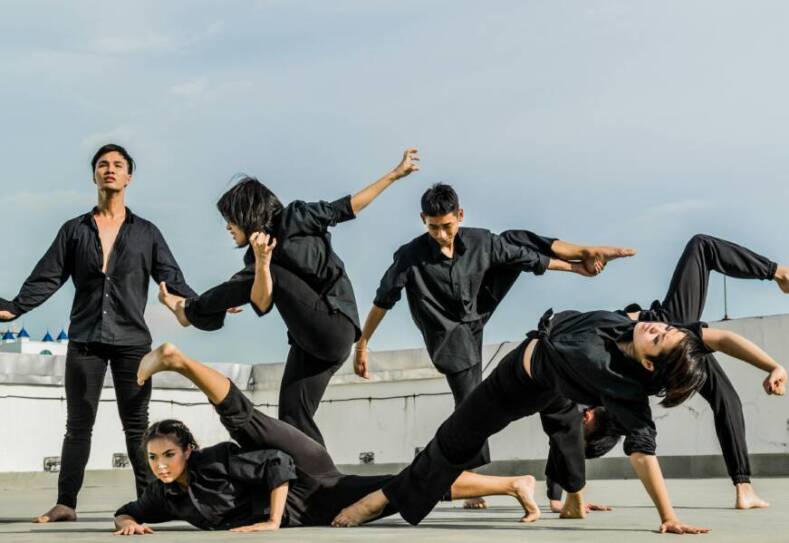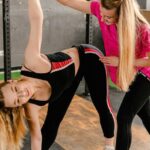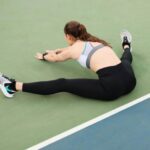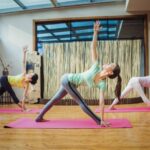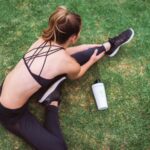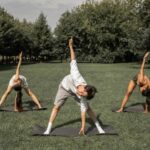Flexibility and mobility are critical components of physical health, each playing a distinct role in overall fitness. Flexibility refers to the ability of muscles to stretch when needed, contributing to the ease of movement within the body’s natural range. It is a static measure, indicating the length a muscle can reach without being active. Considered a passive characteristic, flexibility is essential for completing daily tasks and a foundational element for athletes to perform their best.
Mobility, however, takes the concept a step further by encompassing not only the flexibility of muscles but also the range of motion within the joints. It integrates strength, balance, and coordination to control muscle movements through their entire range. Unlike flexibility, mobility is dynamic, involving movement and the ability to maintain control throughout that movement. Strong mobility is often indicative of healthy, well-functioning joints and the muscular systems that support them.
In the realm of fitness, both flexibility and mobility are vital, but they serve different purposes. While flexibility targets the lengthening of muscles, mobility addresses the function and health of the joints. An individual may possess great flexibility but lack mobility if there is not enough strength or control to move a joint through its full range of motion. Understanding and developing both attributes can lead to improved performance, decreased risk of injury, and enhanced quality of life.
Understanding Flexibility
Flexibility refers to the ability of muscles to stretch and the ease with which a person can move a body part through a full range of motion passively. It’s a critical component of overall fitness and has several key elements that contribute to its development.
Components of Flexibility
Flexibility is primarily determined by two components: the elasticity of one’s muscles and the plasticity of connective tissues. Elasticity allows the muscle to return to its original shape after being stretched, while plasticity enables long-term lengthening. Effective flexibility training often involves stretching exercises that target both attributes.
Role of Connective Tissues
Connective tissues, including ligaments and tendons, play a vital role in flexibility. Ligaments attach bone to bone and provide joint support, while tendons connect muscles to bones. The health and flexibility of these tissues directly affect a joint’s range of motion and the muscle’s ability to lengthen during a stretch.
Importance of Muscle Length
Muscle length is crucial for optimal flexibility. It is affected by the passive stretching of muscles, where an external force, such as gravity or a partner, assists the stretch. Adequate muscle length can prevent injuries and improve performance by allowing joints to move through their full range of motion efficiently.
Exploring Mobility
Mobility is essential for optimal physical function, involving the joints’ ability to move through their full range without pain or restriction. It encompasses not just range of motion but also the balance and stability necessary for controlled movements.
Joint Range of Motion
Joint range of motion refers to the capacity of joints to move through the full extent of their possible movements. This includes flexion, extension, abduction, adduction, and rotation, depending on the joint’s specific anatomy. Adequate mobility allows a joint to move freely within these movements, which is imperative for everyday tasks and physical performance.
- Flexion: Decrease in angle between two body parts, such as bending the elbow.
- Extension: Increase in angle, straightening the elbow.
- Abduction: Movement away from the central line, lifting the arm to the side.
- Adduction: Pulling the arm back to the body.
- Rotation: Circular movement around an axis, turning the head side to side.
Balance and Stability
Balance and stability are the outcomes of well-coordinated mobility where the body maintains its center of gravity over its base of support. Stability is particularly significant in mobility as it involves multiple joints and muscles working harmoniously to perform movements without falling or losing control. Proper mobility training enhances proprioception, the body’s awareness of its position and movement, which directly contributes to stability and balance.
Ankle and Shoulder Mobility
Ankle and shoulder joints have distinct mobility needs due to their unique structures and range of motion.
- Ankle Mobility: Essential for walking, running, and squatting, a mobile ankle allows for dorsiflexion (bringing the toes up towards the shin) and plantarflexion (pointing the toes down). It is crucial for absorbing impact and adapting to various surfaces.Ankle MovementDescriptionDorsiflexionToes move towards shinPlantarflexionToes point away from shin
- Shoulder Mobility: The shoulder’s ball and socket joint afford a large range of motion, including overhead press movements and reaching across the body. Proper mobility at the shoulder is required for arm rotations and lifting objects without discomfort.Shoulder MovementDescriptionAbductionRaising arm out to the sideRotationTwisting arm at the shoulder
Differences Between Mobility and Flexibility
Flexibility refers to the muscles’ ability to elongate. When individuals think of flexibility, they often envision the muscles stretching like elastic bands, expanding their length before returning to a resting state. Flexibility is essential as it contributes to the performance of daily activities and ensures that the body can perform a wide range of movements without discomfort or risk of injury.
On the other hand, mobility encompasses not only the muscle’s flexibility but also the joint’s ability to move freely through its range of motion. It involves the harmonious function of bones, joints, muscles, and the nervous system. Mobility is crucial for maintaining proper movement patterns and ensuring that joints are moving as they should.
Here, control is a key differentiator:
- Flexibility: The passive lengthening of muscles.
- Mobility: The active control of joints through their full range of motion.
A simple way to differentiate them:
- Flexibility is about capacity—how far a muscle can stretch.
- Mobility is about capability—how a joint can move and the control over that movement.
Muscles and joints play unique roles in both flexibility and mobility:
- Muscles must have the necessary length (flexibility) to allow movement.
- Joints require adequate strength and neuromuscular coordination for controlled movement (mobility).
In essence, while flexibility addresses the question of “Can the muscles stretch far enough?”, mobility asks “Can the body move with strength and control through a range of motion?”. Both components are vital for overall bodily function and to minimize the risk of injury.
Flexibility and Mobility Training Techniques
Incorporating various training techniques is essential for enhancing flexibility and mobility. Effective methods include static and dynamic stretching, myofascial release with foam rolling, and the structured practices of yoga and pilates.
Static vs. Dynamic Stretching
Static Stretching involves holding a stretch for a period, typically 15-30 seconds, targeting specific muscles to improve flexibility. Ideal for cooling down, it aids in muscle recovery and the reduction of soreness.
- Example: Hamstring Stretch
Dynamic Stretching is movement-based stretching that warms up the body and increases range of motion by taking muscles through their full range of motion.
- Example: Leg Swings
Foam Rolling and Myofascial Release
Foam Rolling is a self-myofascial release technique using a foam roller to apply pressure on muscle knots and tight tissues, which can improve mobility and decrease recovery time post-exercise.
- Recommended usage: Before or after workouts to aid in muscle relaxation
- Duration: Roll over each muscle group for about 30-60 seconds
Myofascial Release applies pressure to the connective tissue (fascia) to reduce pain and increase mobility. Practitioners may use tools like massage balls for targeted pressure.
- Technique: Apply sustained pressure on tight areas for up to 90 seconds to achieve release
Yoga and Pilates
Yoga emphasizes flexibility, strength, and breathing to boost physical and mental wellbeing. It consists of various postures and poses that stretch and strengthen muscle groups.
- Focus: Balancing flexibility and strength for overall mobility
Pilates focuses on core strength, posture, balance, and flexibility. The exercises in Pilates aim to improve alignment and efficient movement patterns.
- Core principle: Controlled movements for a stable and strong core
Enhancing Athletic Performance
Athletes continuously strive to improve performance by incorporating various training techniques focused on strength, endurance, and mobility. Conditioning these aspects can significantly affect their ability to perform at peak levels.
Strength and Endurance
Strength and endurance are foundational elements of athletic performance. They not only enhance an athlete’s ability to exert force and sustain efforts but also contribute to the effectiveness of flexibility and mobility training. For example, increased hamstring flexibility has been correlated with better outcomes in activities such as vertical jumps and sprinting by enabling a greater range of powerful movements.
- Strength: Key in providing the necessary force for athletic movements.
- Endurance: Enables sustained performance, reducing fatigue over time.
Warm-Up and Active Recovery
A targeted warm-up prepares the body for the demands of physical activity, raising the muscle temperature and consequently improving flexibility. This can reduce the risk of injuries and prime the muscles for better performance.
- Dynamic Stretching: Involves active movements that gently take joints through their full range of motion.
- Light Cardiovascular Activity: Elevates heart rate and body temperature.
Active recovery, consisting of low-intensity exercises post workout or competition, aids in maintaining mobility while promoting circulation. It helps alleviate muscle soreness, thus ensuring athletes are ready for subsequent training sessions.
- Cool Down Exercises: Include slow jogging or walking, followed by static stretching.
- Mobility Work: Focuses on joint health through range of motion exercises.
Proper Form and Technique
Maintaining proper form and technique is crucial for effective athletic performance, preventing injuries, and ensuring the correct muscles are targeted during exercise. Flexibility aids in achieving the proper form by allowing for a greater range of motion, while technique stands as the cornerstone for executing movements efficiently and safely.
- Body Alignment: Proper alignment reduces stress on ligaments, tendons, and joints.
- Controlled Movements: Ensure the correct muscles are engaged and the risk of injury is minimized.
Injury Prevention and Management
Injury prevention and management are crucial components of maintaining peak physical performance. This section explores the roles flexibility and mobility play in reducing injury risks, how identifying muscle imbalances can aid prevention, and the importance of consulting a physical therapist for expert guidance.
Role of Flexibility and Mobility
Flexibility and mobility are integral for injury prevention. Flexibility refers to the ability of muscles to lengthen, allowing for the full range of motion around joints. This characteristic is vital to prevent muscle strains and ligament injuries, which can occur when muscles are unable to stretch adequately during activity. On the other hand, mobility involves both the muscles’ flexibility and the ability of the joints to move freely. Ensuring proper mobility can help athletes avoid joint injuries and maintain optimal movement during their athletic endeavors.
Identifying Muscle Imbalances
Muscle imbalances occur when opposing muscles exhibit disparate strengths or flexibility, leading to incorrect form and increased injury risk. It is essential to identify and correct these imbalances to prevent injury. This can be achieved through:
- Assessment Techniques: Tests like the Functional Movement Screen (FMS) can help identify asymmetries.
- Targeted Exercises: Once imbalances are detected, tailored exercises can strengthen weak muscles and enhance flexibility in tight areas.
Working with a Physical Therapist
A physical therapist specializes in diagnosing and treating injuries, with a strong focus on injury prevention. Working with these professionals can provide:
- Personalized Injury Risk Assessments: They help determine individual injury risks based on one’s flexibility, mobility, and current physical condition.
- Therapeutic Interventions: Customized interventions can include massages, stretches, and strengthening exercises designed to address specific concerns.
- Guided Rehabilitation: In the case of injury, a physical therapist can guide the patient through a progressive rehabilitation process to ensure a safe and effective return to sport.
Incorporating these strategies into one’s training can significantly reduce the potential for injuries and support long-term physical health and athletic performance.
Lifestyle and Environmental Factors
A person’s ability to move and stretch can be significantly influenced by various lifestyle and environmental factors. These aspects can affect both flexibility and mobility over time.
Nutrition and Hydration
Proper nutrition and hydration are fundamental for maintaining tissue elasticity and joint lubrication. A balanced diet rich in antioxidants and healthy fats can contribute to reducing inflammation and supporting circulation, key for joint health. Hydration is essential, as water is a major component of synovial fluid, which reduces friction in joints and facilitates better mobility.
- Vitamins and Minerals:
- Vitamin C: crucial for collagen formation.
- Omega-3 fatty acids: may aid in reducing joint inflammation.
Impact of Aging
Aging naturally leads to a decrease in flexibility and mobility due to changes in muscle mass and connective tissue. An individual’s hereditary genetics can dictate the rate and extent of this decline. Regular physical activity can help mitigate these effects by promoting blood flow and maintaining muscle strength, which is vital for joint function.
- Physical Activity:
- Recommended: Moderate exercise at least 150 minutes per week.
Stress and Relaxation Techniques
Stress can lead to muscle tension, which negatively affects flexibility. The use of relaxation techniques, like deep breathing and progressive muscle relaxation, can aid in stress reduction and promote a relaxed muscular state. Additionally, modalities such as yoga and meditation have been shown to improve both psychological and physiological responses to stress, contributing to better overall flexibility and mobility.
- Relaxation Techniques:
- Deep breathing: can help reduce muscle tension.
- Yoga: combines stress reduction and flexibility exercises.
Developing a Personalized Flexibility and Mobility Routine
Developing a personalized flexibility and mobility routine is essential to improve one’s range of motion, enhance posture, and contribute to overall health. A tailored approach ensures that exercises meet individual needs, focusing on both flexibility and strength for optimal performance.
Assessing Personal Needs
The first step in creating a personalized routine is to assess one’s individual flexibility and mobility needs. This evaluation identifies areas of tightness or limited movement and distinguishes between flexibility-related issues and mobility concerns. One may begin with simple tests for each major joint, noting where range of motion is restricted. For individuals with postural imbalances, targeted assessments by a health professional might be beneficial.
- Joint-by-Joint Assessment:
- Shoulders
- Elbows
- Wrists
- Hips
- Knees
- Ankles
Creating a Balanced Program
After assessing needs, one should create a balanced program that includes stretching exercises for flexibility and strength training for improving mobility. A variety of exercises ensures that all aspects of movement and muscle groups are addressed.
- Flexibility:
- Incorporate stretching exercises such as hamstring stretches, yoga poses, or the use of a resistance band to improve muscle length.
- Mobility:
- Integrate dynamic movements that mimic everyday activities, like lunges and arm circles, which also help strengthen the joints.
Each session should be concise, ensuring that exercises are performed with proper form to prevent injury and maximize benefits.
Monitoring Progress and Adjustments
Regular monitoring of one’s progress is crucial to adapt the routine to the changing needs of the body. Adjustments may be required to further challenge the body or to focus on areas that are lagging.
- Tracking Methods:
- Keep a log of flexibility tests, such as the sit-and-reach test.
- Record mobility exercises and note any improvements in the range of motion or ease of movement.
By consistently evaluating and refining one’s routine, individuals can enhance their quality of life through improved physical capabilities.
